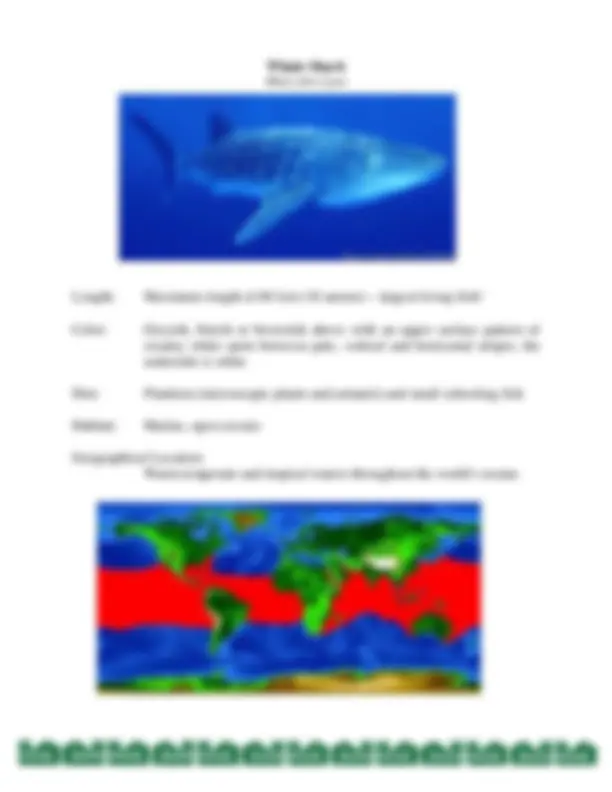









Study with the several resources on Docsity

Earn points by helping other students or get them with a premium plan


Prepare for your exams
Study with the several resources on Docsity

Earn points to download
Earn points by helping other students or get them with a premium plan
Community
Ask the community for help and clear up your study doubts
Discover the best universities in your country according to Docsity users
Free resources
Download our free guides on studying techniques, anxiety management strategies, and thesis advice from Docsity tutors
Information on various shark species, including their size, color, diet, and habitat. The document also includes activities such as graphing the maximum length of each species and creating a shark mobile. Students can use this information to answer questions about shark sizes and safety.
What you will learn
Typology: Exercises
1 / 13

This page cannot be seen from the preview
Don't miss anything!








Shark Species Profiles Background: Sharks have existed for about 400 million years, before dinosaurs roamed the earth! They belong to a class of fish called Chondrichthyes. Chrondrichthyes means "cartilaginous fishes". Theskeletons of sharks and other Chondrichthyans are made of cartilage unlike human skeletons that are made of bone. Although all sharks have some similarities such as having gills and fins, theycome in a variety of shapes, sizes, colors, and personalities. They also live in many different habitats and in different parts of the world. Materials: There are 8 shark species profiles included in this activity with information on size, color, diet, and habitat of each shark. Focus is on sharks that live in waters off the Florida coast althoughsharks from other parts of the world are also included: 1.2. Bull sharkWhite shark 3.4. Tiger sharkGreat hammerhead shark 5.6. Shortfin mako sharkThresher shark 7.8. Whale sharkLeopard shark
In addition, there are also species profiles on closely related rays, skates, and sawfish that mayalso be included in classroom learning activities: 1.2. Atlantic stingrayClearnose skate
Classroom Activities:
Carcharhinus leucas Bull Shark
Length: Maximum length of 11.5 feet (3.5 meters) Color: Pale to dark gray above fading to a pale or white underside Diet: Fish and small sharks Habitat: Marine and freshwater shallow habitats Geographical Location: Live throughout the world
Galeocerdo cuvier Tiger Shark
Length: Maximum length of 14 feet (4.25 meters) Color: Bluish-gray to dark gray or black on top with a yellowish-white underside, dark spots are visible on young sharks but fade as the shark matures Diet: Sea turtles, rays, sharks, bony fishes, sea birds, dolphins, squid, and crustaceans Habitat: Marine, murky waters off the coast from the surface to depths of 1,085 feet (350 meters) Geographical Location: Temperate and tropical waters throughout the world, with the exception of the Mediterranean Sea
Great Hammerhead Shark Sphyrna mokarran
Length: Maximum length of 20 feet (6.1 meters) Color: Dark brown to light grey or even olive color on top, fading to white on the underside Diet: Invertebrates, bony fish, and rays as well as other sharks Habitat: Marine, shallow coastal waters to offshore water depths of 985 feet (300 meters) Geographical Location: Warm temperate and tropical marine waters throughout the world
Thresher Shark Alopias vulpinus
Length: Maximum length of 24.9 feet (7.6 meters) including the long tail fin Color: Dark brown and slate gray to black on top with black spots near the tail, it is white underneath Diet: Small bony fish such as herring, bluefish, and mackerel, they use their long tail fin to stun their prey so it is easier to catch Habitat: Marine, coastal waters to open ocean waters at depths to 1,800 feet (550 meters) Geographical Location: Cold temperate and tropical waters throughout the world's oceans
Rhincodon typus Whale Shark
Length: Maximum length of 60 feet (18 meters) – largest living fish! Color: Greyish, bluish or brownish above with an upper surface pattern of creamy white spots between pale, vertical and horizontal stripes, the underside is white Diet: Plankton (microscopic plants and animals) and small schooling fish Habitat: Marine, open oceans Geographical Location: Warm temperate and tropical waters throughout the world's oceans
Atlantic Stingray Dasyatis sabina
Length: Disk width of 12-15 inches (stingrays are measured this way) Color: Brown or yellowish brown on the top, becoming lighter close to the edge. The underside is white or light gray Diet: Clams, worms, tube anemones, and bivalves Habitat: Marine and brackish water in warm coastal areas, it also lives in some freshwater lakes in Florida Geographical Location: Western Atlantic Ocean from Chesapeake Bay south to Florida and into the Gulf of Mexico
Clearnose Skate Raja eglanteria
Length: Maximum disk width of 19 inches (48 cm) Color: Dark to light brown or gray on the dorsal surface with dark spots and bars sometimes present, the ventral surface is white Diet: Shrimp, crabs, and small fish Habitat: Marine inshore waters Geographical Location: Atlantic Ocean – from Massachusetts south through Florida and into the Gulf of Mexico
SHARK
LENGTH
GRAPH
Bull Shark
11.5 feet
White Shark
22.3 feet
Tiger Shark
14 feet
Great HammerheadShark
20 feet
Shortfin Mako Shark
13 feet
Thresher Shark
24.9 feet
Whale Shark
65.5 feet
Leopard Shark
7 feet
Smalltooth Sawfish
24.7 feet
Human Adult
6 feet
Human Child
4 feet
LENGTH (feet)
5
10
15
20
25
30
35
40
45
50
55
60
65
Instructions: Each box represents five feet in length. Color in the boxes from left to right until you reach the appropriate boxrepresenting the length of the shark on that line. Use your graph to answer the questions below: 1.^
Which shark is the shortest?
2.^
Which shark is the longest?
3.^
Does the size of a shark indicate how dangerous it is?
Shark Species Profiles : Graphing and Question/Answer Activity Sheet